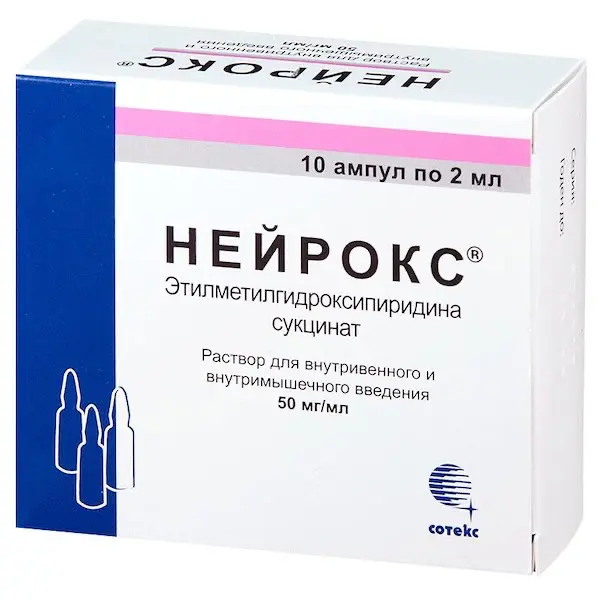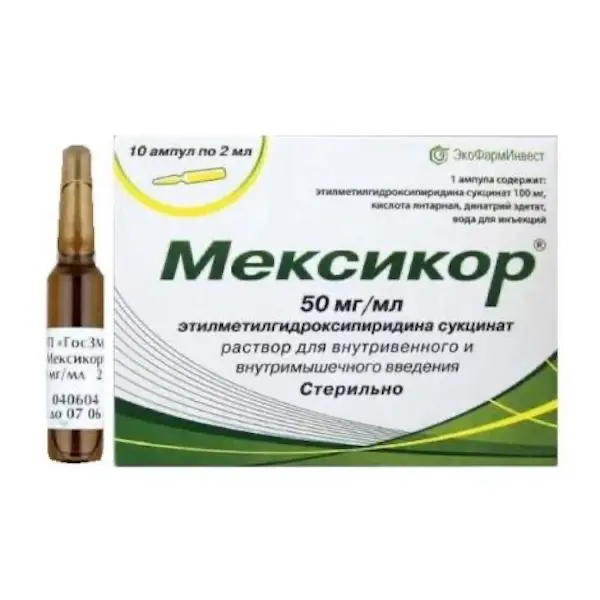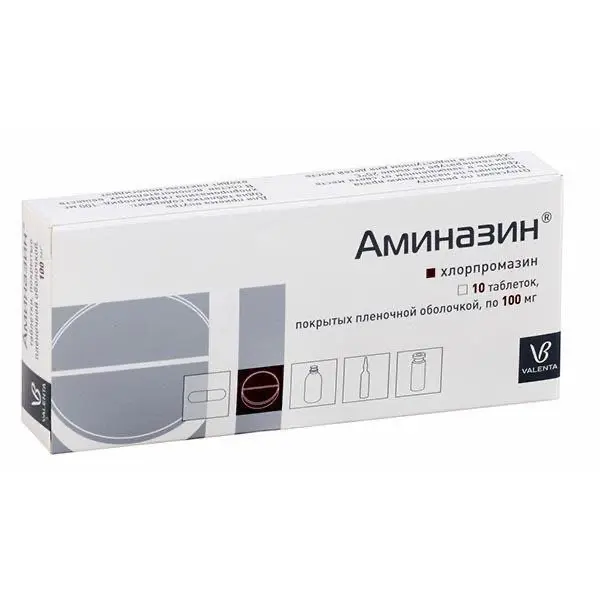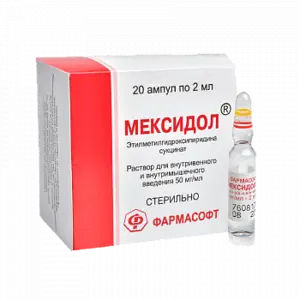Description
Neurox Pharmacodynamics
Ethylmethylhydroxypyridine succinate (EMGPS) is an inhibitor of free radical processes, membrane protector with antihypoxic, stress-protective, nootropic, anticonvulsant and anxiolytic effect. It belongs to the class of 3-oxypyridines. The mechanism of action is due to the antioxidant and membrane-protective properties. It suppresses lipid peroxidation, increases superoxidase activity, increases lipid-protein ratio, improves cell membrane structure and function. Modulates the activity of membrane-bound enzymes, receptor complexes, which promotes their binding to ligands, preserving the structural and functional organization of biomembranes, transport of neurotransmitters and improving synaptic transmission. Increases the concentration of dopamine in the brain. Enhances compensatory activation of aerobic glycolysis and reduces the degree of inhibition of oxidative processes in the Krebs cycle under hypoxia with an increase in adenosine triphosphoric acid and creatine phosphate, activates the energy-synthesizing function of mitochondria. Increases the body’s resistance to various damaging factors in pathological conditions (shock, hypoxia and ischemia, cerebral circulatory disorders, intoxication with ethanol and antipsychotic drugs). Improves metabolism and blood supply to the brain, microcirculation and blood rheology, reduces platelet aggregation. It stabilizes blood cell membranes (erythrocytes and platelets), reducing the likelihood of hemolysis. It has hypolipidemic effect, reduces the content of total cholesterol and low-density lipoproteins. It normalizes metabolic processes in the ischemic myocardium, reduces the zone of necrosis, restores and/or improves myocardial electrical activity and contractility, as well as increases coronary blood flow in the ischemic zone, increases the antianginal activity of nitro preparations, reduces the consequences of reperfusion syndrome in acute coronary failure.
Stress-protective effect is manifested in the normalization of post-stress behavior, somatovegetative disorders, restoration of sleep-wake cycles, disturbed learning and memory processes, reduction of dystrophic changes in various brain structures.
Ethylmethylhydroxypyridine succinate has a pronounced anti-toxic effect in withdrawal syndrome, eliminates neurological and neurotoxic manifestations of acute alcohol intoxication, corrects behavioral and cognitive disorders. Under the influence of ethylmethylhydroxypyridine succinate, the effect of tranquilizing, neuroleptic, antidepressant, sleeping pills and anticonvulsants increases, which allows reducing their doses and side effects.
Indications
– Acute disorders of cerebral circulation (in the complex therapy);
– Craniocerebral trauma, consequences of craniocerebral injuries;
– discirculatory encephalopathy;
– vegetative (neurocirculatory) dystonia syndrome;
– Mild cognitive disorders of atherosclerotic genesis;
– Anxiety disorders in neurotic and neurosis-like conditions;
– Acute myocardial infarction (from the first day) as part of the treatment;
– Primary open-angle glaucoma of different stages, as part of the treatment;
– management of withdrawal syndrome in alcoholism with a predominance of neurosis-like and autonomic-vascular disorders;
– acute intoxication with antipsychotic drugs;
– Acute pyo-inflammatory processes of the abdomen (acute necrotizing pancreatitis, peritonitis) as part of the treatment.
Contraindications .
– Increased individual sensitivity to the drug or its components;
– Acute renal failure;
– acute hepatic failure;
– pregnancy;
– breast-feeding;
– childhood.
With caution:
Allergic diseases and reactions in the history, including hypersensitivity to sulfites.
Dosage and administration method
- Intramuscularly (i.m.) or intravenously (i.v.) (by trickle or drip). During infusion method of administration the drug should be diluted in 0.9% sodium chloride solution.
- Neurox® by jetting is administered slowly within 5-7 minutes, by drip – at a rate of 40-60 drops per minute. Maximum daily dose should not exceed 1200 mg.
- In acute impairment of cerebral circulation Neurox® is used in combination therapy in the first 10-14 days – by IV drops 200-500 mg 2-4 times daily, then by IV drops 200-250 mg 2-3 times daily during 2 weeks.
- In case of craniocerebral trauma and craniocerebral injuries sequelae Neurox® is used during 10-15 days by IV drip 200-500 mg 2-4 times daily.
- In decompensated dyscirculatory encephalopathy Neurox® is administered by IV streaming or dropwise in dose 200-500 mg 1-2 times per day during 14 days. Then it should be administered in a 100-250 mg/day by injection for the next 2 weeks.
- For course prophylaxis of discirculatory encephalopathy Neurox® is administered in a monthly dose of 200-250 mg 2 times a day during 10-14 days.
- In cases of neurocirculatory dystonia, neurotic and neurosis-like conditions the drug is administered intravenously 50-400 mg per day during 14 days.
- In mild cognitive disorders in elderly patients and in anxiety disorders, the drug is administered in/m in a dose of 100-300 mg per day for 14-30 days.
- In acute myocardial infarction, Neurox® is administered as part of complex therapy by IV or IM within 14 days against traditional therapy of myocardial infarction (including nitrates, beta-adreno-blockers, angiotensin-converting enzyme (ACE) inhibitors, thrombolytics, anticoagulants and antiaggregants as well as symptomatic medicine, when indicated).
- During first 5 days, for maximal effect, Neurox® is given intravenously, during next 9 days the drug can be administered intramuscularly.
- Intravenous administration of the drug is carried out by drop infusion slowly (in order to avoid side effects) within 30-90 minutes (in 100-150 ml of 0.9% sodium chloride solution or 5% dextrose (glucose) solution), if necessary, slow trickle intravenous administration of the drug for at least 5 minutes is possible.
- The drug is administered (intravenously or intravenously) 3 times a day, every 8 hours. The daily dose is 6-9 mg/kg of body weight, single dose – 2-3 mg/kg of body weight. The maximum daily dose should not exceed 800 mg, a single dose – 250 mg.
- In open-angle glaucoma of various stages Neurox® is administered 100-300 mg/day in a single unit dose 1 to 3 times daily for 14 days.
- In withdrawal alcohol syndrome Neurox® is administered intravenously or by IV drops at a dose of 200-500 mg 2-3 times a day during 5-7 days.
- In acute intoxication with antipsychotic drugs the drug is administered by IV in a dose of 200-500 mg per day for 7-14 days.
- In acute pyo-inflammatory processes of abdominal cavity (acute necrotizing pancreatitis, peritonitis) Neurox® is prescribed during first day both during preoperative and postoperative periods. Doses administered depend on the form and severity of the disease, prevalence of the process, variants of the clinical course. Drug should be withdrawn gradually only after a stable positive clinical and laboratory effect.
- In acute edematous (interstitial) pancreatitis Neurox® is prescribed 200- 500 mg 3 times a day, by IV drops (in 0.9% sodium chloride solution) and intravenously. Mild degree of severity of necrotic pancreatitis – 100-200 mg 3 times a day by infusion (in 0.9% sodium chloride solution) and intravenously. Moderate severity – 200 mg 3 times a day, IV drops (in 0.9% sodium chloride solution). A severe course – in a pulse dosage of 800 mg during the first day, with twice-daily administration; then 200-500 mg twice daily with a gradual reduction of the daily dose. Extremely severe course – the initial dosage of 800 mg/day until stable relief of pancreatogenic shock; after stabilization, 300-500 mg 2 times daily by IV drip (in 0.9% sodium chloride solution) with gradual reduction of daily dose.





